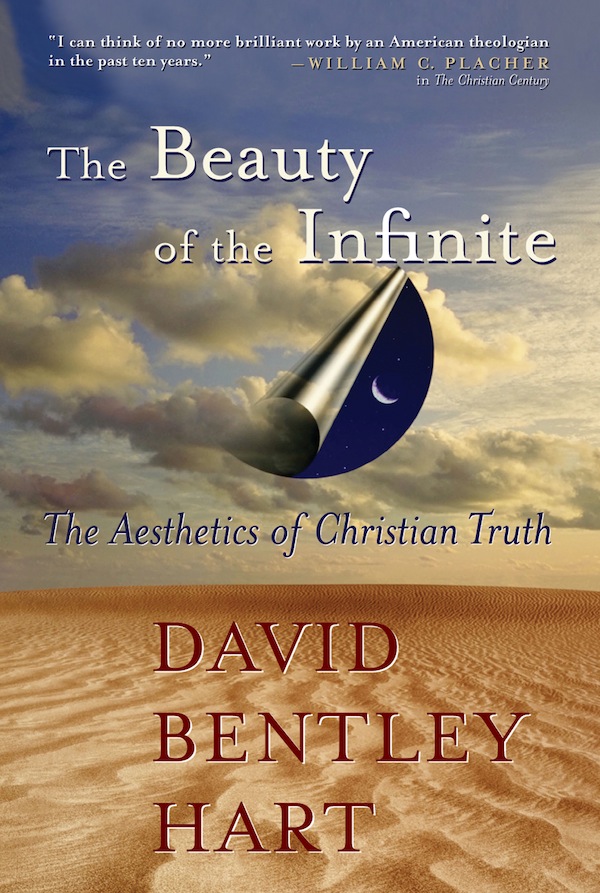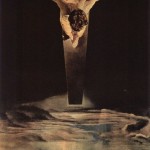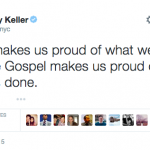If you are an Anglophone Christian with the internet and theological pretentions (and a taste for good prose), it’s hard to escape David Bentley Hart. And so eventually you learn that he wrote a magnum opus titled “The Beauty of the Infinite: The Aesthetics of Christian Truth”, but you also learn that it is a very dense book, that it has deterred many a reader, that it crosses swords with foreboding (particularly, but not only, from an Anglo-American perspective) French philosophers like Deleuze and Derrida, and so Beauty starts to take the shape of one of those books that many discuss but that no one has read. If so, that’s a shame.
Beauty is an important book. It’s also quite a readable book–once you get into it–at least if you have a basic grounding in philosophy and theology (or, I guess, what used to be considered, and maybe only in the Old Continent, a basic grounding in philosophy and theology).
And so, here, I hope to do not just a mini-review but, Deo volens, a series of posts on the most interesting aspects of the book, in the hope of disseminating its ideas and encouraging people to read it. Maybe over time it will be a kind of “introduction” or “study guide” to Beauty.
For all its “hairiness”, the thrust of Beauty is actually pretty simple. The book is essentially a blueprint to a Christian response to postmodern philosophy. Postmodernism, in Hart’s telling (which is correct—and yes, Hart is well aware of how slippery the term is), is an opposition to metanarratives as such. All metanarratives are really power plays, and acts of violence. Modern Enlightenment’s myth of universal reason turned out to be the pretext for the colonial West’s imperialism over other cultures; Communism’s rhetoric of liberation of the working class led to the Gulag. Because the reality of the world is difference, all metanarratives (particularly metaphysics) are lies since they seek to suppress or elide differences in the Procrustean bed of some dogmatic, totalizing principle, whether Plotinus’s One, or Kant’s pure reason, or Hegel’s Geist.
In this reading, then, Christianity is the metanarrative to be resisted par excellence, the most false of all the metanarratives, since it is a metanarrative that represents itself as a metanarrative of peace–even though all metanarratives are violence. And does not the history of the Christian Church confirm this?
To respond to this, it is not sufficient to point out the obvious–that postmodernism itself is a metanarrative, and that if all metanarratives are false, then postmodernism is merely its own reductio ad absurdum; that as a metanarrative, like all metanarratives, it is a power play against other metanarratives, one that dogmatically excludes other metanarratives, one that (like every other metanarrative, a good postmodern would note) merely presupposes what it purports to prove: that the reality of the Universe is violence–nature red in tooth and claw–, and that therefore all narratives of peace are lies. After all, to this, the postmodern, always the playful ironist, might simply respond: “Maybe–so what?”
Christianity must come up with a better answer to the postmodern critique, Hart writes, because he’s got a book to write it strikes at the heart of Christianity–its ontological claim that the reality of being itself is supreme peace, a claim that, in the midst of history’s killing fields, cannot be merely asserted, but must always be made credible anew, in word and deed.
To Hart, the only possible answer to the postmodern critique must be the understanding that God–because He is Tri-Une–is infinite beauty. Because God is infinite, he is not one being among many, but rather the sheer act of to be itself, and so is not a rival to mere beings; because God is infinite, he has no need of creation, and therefore creation is an act of selfless generosity; because God is infinite, he has no interest in fitting differences within a mere totality, which could only be an oppressive, man-made myth (the postmoderns are right about that), but rather, because he is infinite, Trinitarian beauty, all differences find their yes in the splendrous harmony of the Trinitarian perichoresis–the self-giving union in love of the Father and the Son, in the procession of the Spirit.
Indeed, the postmoderns are right to critique the Enlightenment myth of pure reason as merely a seductive rhetoric; where they go wrong is in thereby rejecting all rhetoric. Christianity should “own itself” as a rhetoric, as an all-encompassing metanarrative, because God is infinite beauty, and, therefore, in a sense, a rhetoric himself. Whether we “buy” a rhetoric or not is ultimately an aesthetic movement–because our hearts were made for God and God is infinite beauty. Christians should point to God’s ultimate rhetoric–his Word–which is the form of Jesus Christ. In the words of Hans Urs von Balthasar, whom Hart claims as the biggest influence on Beauty, “love alone is credible”–a love who is revealed as infinite beauty, thereby making credible, in the aesthetic response it summons, Christianity’s rhetoric of peace.
This is basically the argument of the book.
The way the book proceeds is that, in the first part, Hart goes through the main postmodern philosophers–particularly Deleuze, Derrida, Foucault and Lévinas–, expositing their philosophy and then hammering away at their inconsistencies. I think this is why so many give up on the book. Even for those trained in it, continental philosophy can be very arid, and Hart takes a lot of background for granted. But when Hart gets to Nietzsche–to him, the ultimate postmodern philosopher and most incisive recent critic of Christianity–he really gets into his groove, and the book becomes really readable.
But these battles with continental philosophy were really only the preparatory artillery bombardment that softens up the enemy positions before the main assault. The heart of the book is its “Minor Dogmatics”–Trinity, Creation, Salvation, Eschaton–in which Hart really unfolds his theme of God-as-infinite-beauty, and the centrality of that theme both to Christian dogmatics and to any credible Christian response to the world we live in. And it is really the chapter on the Trinity from which everything else comes and to which everything goes (appropriately enough).
It is because God is Triune that he is infinite beauty–not the cold, distant beauty of Plotnius’ One, but the symphonic, poetic love song of the Father to the Son, and of the Son to the Father, in the harmony of the Spirit. Furthermore, a monist God could not be infinite, but merely a totality–Plotinus’ One is merely the skyhook from which the rest of existence dangles. God is infinite because of the infinite love that unites Father and Son in the Spirit in the infinity of their self-gift, and creation itself is the love-song of the Father to the Son in the Spirit, so that creation is enfolded in the embrace of the perfectly transcendent–because infinite–God. Creation, then, far from being a realm of illusion and destitution (Platonism, Gnosticism), or the theater of meaningless strife and sacrifice (paganism, Nietzsche, postmodernism–take your pick), is instead an endless theophany, the song of creation, a living icon of the true God who is Father, Son and Holy Spirit.
In this book, Hart the pugilist frequently comes out. Not just against the poor continental philosophers, but also against more than a few of Hart’s fellow theologians–Hart will plow through everything that stands athwart his project. And, indeed, Hart is famous for pummeling adversaries into submission, with his pavonine displays of vocabulary and bookish erudition. This aspect of Hart’s style seems unavoidable, and one’s appreciation seems to depend largely on which side one finds oneself. (I thoroughly enjoyed his evisceration of Karl Barth’s “barbarous” reading of the analogia Entis–Barthians may feel differently.) But, after all, it makes for lively reading, and it fills the book with gems, such as a highly original reading of Anselm’s Cur Deus Homo? and a spirited and necessary defense of the doctrine of divine impassibility.
All in all, I found very little to disagree with in Hart’s book. This should hardly be surprising, since Hart unapologetically hails from the tradition that you can call “classical Christianity”–the common heritage of the first fifteen centuries of Christianity, and is notable among Eastern Orthodox theologians for his scrupulously fair readings of those pears of discord, Augustine and Aquinas. Although Hart is not the first to make a case for a theology of beauty as the best Christian response to Modernity (he fully recognizes his debt to Balthasar) it is a case that needs to be made, and made well, and he discharges that obligation quite fittingly.
Hopefully I will write more later.
EDIT: It turns out the great blogger and theologian Peter Leithart did a summary of the book. It’s available online in various archives, but it’s hard to search for (which is why I didn’t know about it), but, gratia Dei, commenter collated it and put it online. Given that the summary I wanted to do already exists (and done by someone much more competent than me) I suspect I’ll do a lot less writing about Beauty than I thought I would, although I might still write a few things. Stay tuned. In the meantime, Leithart’s summary is a great resource.











